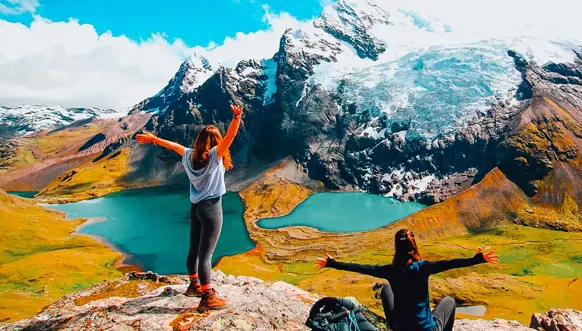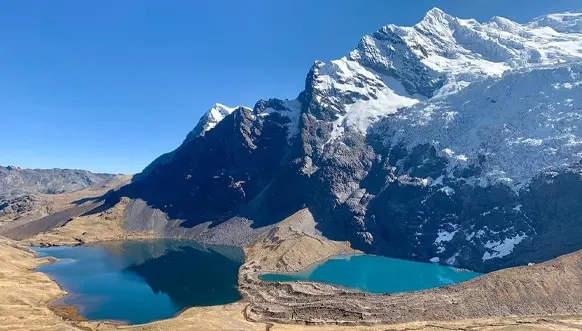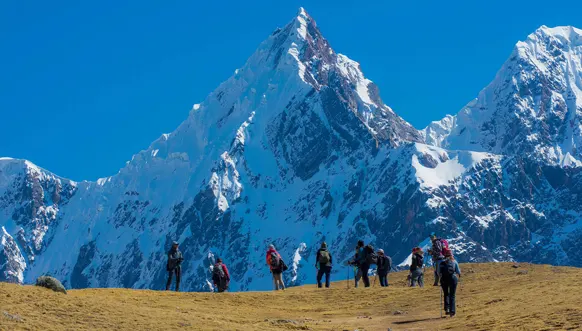5 Days / 4 Nights
Ausangate Trek Peru: Ausangate Mountain Tour
Discover Ausangate! Ausangate Mountain has held great significance since the time of the Incas and remains one of the most revered mountains today. In Andean belief, it is considered a powerful deity, and it also plays a prominent role in modern Christian worship. Known as Apu Ausangate, this sacred peak is steeped in spiritual importance.
Our 5-day Ausangate tour from Cusco is designed to immerse you in breathtaking high-altitude landscapes on a route that is still relatively untouched by mass tourism. You’ll have the chance to witness traditional Andean communities, stunning mountain scenery, vividly colored lakes, and encounter Andean camelids like llamas, alpacas, and vicuñas in their natural environment.





ITINERARY
Cusco – Tinke – Upis – Huayna Ausangate Lagoon
We begin our journey bright and early at 4:30 a.m., picking you up from your hotel in Cusco. Our drive will take us to the town of Ocongate, passing through popular villages in the southern valley, including Huaro, Piquillacta, and Andahuaylillas. Next, we’ll stop at the community of Tinki, where you will have a short window to purchase any last-minute supplies. Remember, this is your final chance for these purchases.
Once we arrive at the Tinke camp, our team of muleteers and support staff will be ready to greet us with a delicious breakfast. Afterward, we will continue our trek to the next campsite in the Upis community. The trail runs along the base of Ausangate Mountain, offering stunning views throughout the hike. Along the way, we will see herds of llamas and alpacas grazing in the open, with opportunities to pause and take photos with these magnificent animals.
Upon reaching Upis, we will enjoy a prepared lunch at our campsite, giving us a chance to relax and savor hot beverages during our break. In the evening, we’ll visit one of the first lagoons of our 5-day trek, known as Huayna Ausangate. Here, we’ll take in the sunset and capture some beautiful photographs.
Dinner and overnight stay will be at the Upis camp.
Upis – Yanacocha – Hatun Puca Cocha
We will wake up early for breakfast and energize ourselves. After preparing our backpacks and the horses, we will follow the trail around the Ausangate glacier. This time, we will have to walk uphill to reach the Arapa pass at 4800 meters above sea level. From this point, we can observe the mountainous geography combined with different lagoons resulting from the glacier thaw.
Upon reaching the Arapa pass, we will begin to descend until we reach the Yanacocha lagoon, also known as the black lagoon. During our descent, we will be on the lookout for wildlife in the area. It is very likely that we will see chinchillas or vizcachas, and sometimes deer inhabit this area. With luck, we might even see vicuñas. The presence of the Andean condor, the largest flying bird in the world, is possible, so it’s good to be attentive to any movement in the landscape.
We will have lunch upon reaching our camp, near the Hatun Puca Cocha lagoon. You will feel the peace that only these Andean landscapes can offer. In the late afternoon and evening, weather permitting, we may observe the stars in all their splendor. We will have a brief talk about constellations before dinner and rest.
Hatun Puca Cocha – Ausangate Cocha – Palomani Pass – Sorapata
This third day, we will recharge with a hearty breakfast, as it is the most demanding of our journey. After breakfast, we will ascend for 2 and a half hours to the Ausangate pass (4750 meters above sea level). From this point, the entire landscape gives us a colossal impression of the geography, making you feel small in comparison to the scenery. Next, we will begin to descend towards the Ausangate Cocha lagoon, where we will enjoy lunch amid the Ausangate and the lagoon. After a short break, we will continue ascending to Palomani pass at 5200 meters above sea level. Upon reaching the summit, we will have a short break to enjoy the scenery before continuing our journey.
After our break, we will continue, this time on a downhill trail, walking until we reach the Huchuy Finaya community located at 4650 meters above sea level. This community still maintains many ancestral traditions from the time of the Incas. We will make a small payment or offering to the mountain alongside its community members, expressing gratitude to Pachamama for allowing us to walk on its lands.
Finally, we will continue our journey with less complex features until we reach Sorapata, where our camp will be waiting for us. We will relax our bodies with hot drinks and rest after an intense day.
Sorapata – Jampa Pass – Pacchanta
As with every day, we will begin early. After finishing breakfast, we will hike to the Jampa Pass, a journey that will take us about 3 hours. The trail gradually inclines, so we’ll need to pace ourselves as we walk. Along the way, we’ll enjoy breathtaking views of the Callangate Glacier, the second-highest snow-capped peak in southern Cusco, following Ausangate. During this segment of our trek, we’ll once again spot herds of llamas and alpacas grazing on the hillsides.
Upon reaching the Jampa Pass, we will start our descent, crossing some of the seven most well-known lagoons in the Vilcanota mountain range. Each lagoon has a unique name that reflects its distinct characteristics. We will stop for lunch amid the stunning mountains and then head to a viewpoint where we can take in a panoramic view of these turquoise lagoons. Afterward, we will continue our hike for about two more hours until we arrive at the community of Pacchanta. There, we will drop off our backpacks and enjoy the medicinal thermal waters available in the village. We will celebrate completing the Ausangate circuit and take the time we need to relax our bodies.
Dinner and overnight stay will be in Pacchanta.
Pacchanta To Cusco
After a 3-hour walk back to Tinqui, we will have time to explore this charming Andean town. Later, we will head back to Cusco in our private transportation, arriving around 18:00 hours, thus concluding our tour.
RECOMMENDATIONS: WHAT SHOULD I BRING?
- Backpack with rain cover.
- Sleeping bag. Essential to bring suitable clothing for both warm and cold weather, including a waterproof jacket.
- Rain pants and lightweight pants. Don’t forget to bring trekking shoes, sneakers, or sandals (for showers and thermal baths), wool or synthetic socks, and a sweater to adapt to different weather conditions during the hike.
- Rain poncho and a hat.
- Sunscreen, insect repellent, disinfectant gel, water bottle, and sterilization tablets, toiletries, and toilet paper.
- Camera (wrapped in a plastic bag).
- Flashlight and batteries.
- Some selected snacks such as chocolate bars and dried fruits.
- Original passport, original ISIC student card, and extra money in soles.
NOTES:
- We will climb up to 5200 m / 17060 ft. Considering the extreme weather of this trip, it can be tough work. We want you to remember this hike with a smile on your face, so please make sure you are well acclimated, in good shape, and healthy.
- Due to the weather becoming very cold and cloudy, it’s important to note that wet clothes will not dry overnight. So, take some spare clothes.
Included
- Transportation from the hotel to the town of Tinke (Round trip).
- Entrance to Ausangate Park.
- Professional bilingual guide (Spanish and English).
- High-quality camping equipment (professional tents, Doite Cima 4 model, extra light / 4.5 kg for two people. Sleeping mats, dining tent with table and chairs, toilet service tent).
- Meals during the excursion (Breakfast, lunch, dinner, snacks / vegetarian option).
- Cook and kitchen staff.
- We have mules and muleteers who will transport all our camping equipment and the personal luggage of each participant, with a limit of up to 8 kg per person.
- First aid kit and oxygen cylinder.
Not Included
- Breakfast on the first day.
- Sleeping bag (if you don't have one, the agency can rent a special bag for this route with its respective polar sheet) $20 for 5 days.
- Hiking poles (if you don't have them, the agency can rent them) $15 per pair for 5 days.
- Other services not mentioned.
